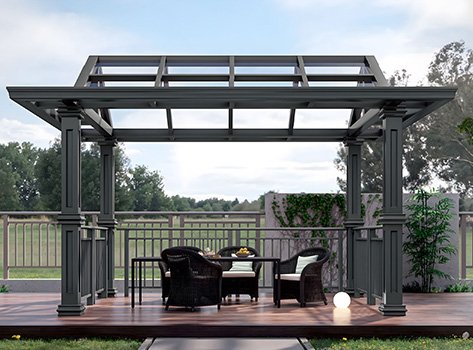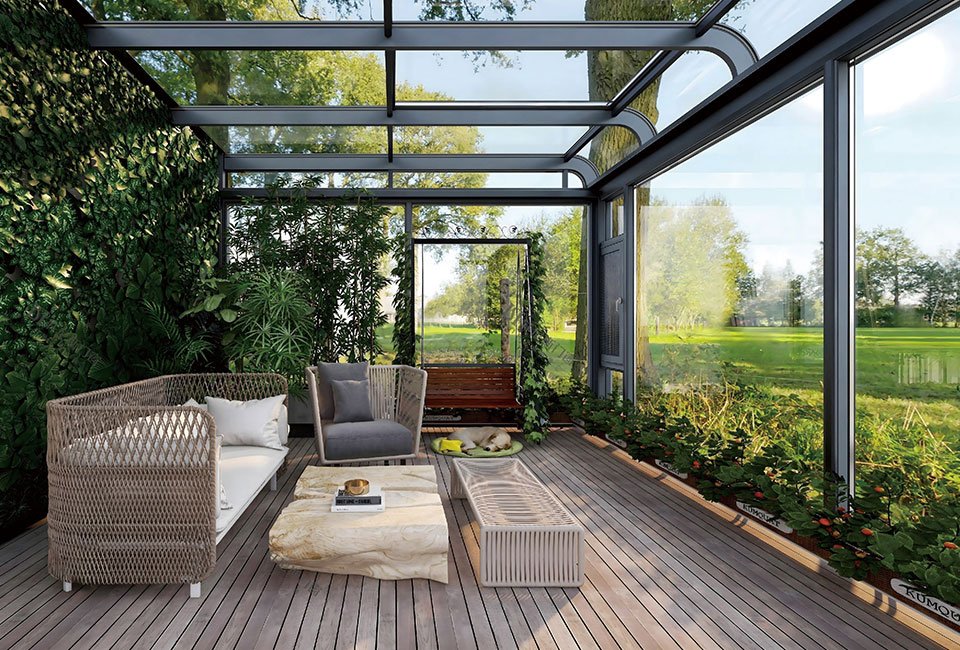Sunrooms are a beautiful addition to any home, offering a space to enjoy the outdoors while staying sheltered from the elements. However, they can also present challenges when it comes to temperature control. With the right design and materials, a sunroom can be an energy-efficient solution that reduces heating and cooling costs. Here’s how you can make your sunroom energy-efficient and comfortable year-round.

1. Use Energy-Efficient Windows
The windows in your sunroom are critical to its energy efficiency. Traditional single-pane windows are poor insulators and can result in heat loss during the winter and heat gain in the summer. To maximize energy efficiency, opt for double or triple-pane windows with low-emissivity (Low-E) glass. These windows have an insulating layer between the panes and help to block UV rays while keeping heat in during the winter and out during the summer. Additionally, argon or krypton gas between the panes further improves insulation.
2. Install Insulated Doors
Just like windows, doors are key components when it comes to energy efficiency. Choose doors with insulated cores to minimize the transfer of heat between your sunroom and the rest of your home. Sliding or French doors with energy-efficient glazing can help keep your sunroom comfortable without letting in too much heat or cold. This can significantly reduce the need for heating in the winter and cooling in the summer.
3. Proper Ventilation
Ventilation plays an essential role in controlling the temperature of your sunroom. Proper airflow can help regulate the temperature, reducing the need for excessive heating or cooling. Ceiling fans, operable windows, or even vented skylights allow hot air to escape in the summer, preventing the sunroom from overheating. In colder months, using a ventilation system or opening the windows briefly can reduce humidity levels and keep the space fresh without turning on the heat.
4. Utilize Solar Heating
Sunrooms are often bathed in sunlight, which can be harnessed to provide natural heating during the colder months. Passive solar heating is a simple yet effective strategy. South-facing sunrooms (in the Northern Hemisphere) allow sunlight to stream in, warming the space during the day. Thermal mass materials like stone, concrete, or tile floors can absorb the heat during the day and release it slowly in the evening, helping to maintain a comfortable temperature in the evening without turning up the thermostat.
5. Opt for Energy-Efficient Roofing
The roof of your sunroom is another factor that impacts its energy efficiency. A reflective or cool roof can help prevent the sunroom from overheating in the summer. These roofs reflect more sunlight and absorb less heat than standard roofing materials, keeping your sunroom cooler and reducing the need for air conditioning. Additionally, insulated roofing can help keep the heat inside during winter, preventing it from escaping and saving on heating costs.
6. Insulation and Shading
Insulating the walls of your sunroom helps to regulate the temperature and maintain a comfortable environment. If your sunroom is not already insulated, consider adding insulation to the walls, ceiling, and floor. Blown-in or spray foam insulation can fill gaps and reduce the amount of heat lost or gained. Additionally, exterior shading devices like awnings, pergolas, or shade screens can reduce the amount of direct sunlight entering the room, helping to keep the space cooler during the summer.
7. Use of Smart Thermostats
A smart thermostat can optimize the temperature control of your sunroom by adjusting the heating and cooling systems based on the time of day, occupancy, and weather conditions. This allows your sunroom to stay at a comfortable temperature without wasting energy. You can set it to heat or cool the room only when you plan to use it, saving on energy bills when the room is empty.
8. Energy-Efficient Lighting and Appliances
If you plan to use your sunroom as a living space, consider energy-efficient lighting and appliances. LED bulbs consume less electricity and produce less heat compared to incandescent bulbs. If you’re using your sunroom in the evening, using LED lights can reduce both your cooling and electricity costs. For appliances, consider energy-efficient options like ceiling fans or small space heaters that use less energy to maintain a comfortable temperature.
9. Proper Sealing
Ensuring that your sunroom is properly sealed will prevent air leaks that can let conditioned air escape. Pay attention to weatherstripping around windows and doors, and inspect for gaps or cracks in the walls or ceiling. Sealing these gaps will help maintain the temperature inside and reduce the strain on your heating and cooling systems.
10. Consider the Use of Energy-Efficient Materials
When constructing or renovating your sunroom, select energy-efficient building materials. For example, using low-E glass, insulated concrete, or eco-friendly flooring options like bamboo or cork can improve the overall energy performance of the space. Even small changes, like adding thermal curtains or using tinted window films, can make a noticeable difference in your energy bills.

Conclusion
Energy-efficient sunrooms are not only better for the environment but can also help you save money on your energy bills. By utilizing energy-efficient windows and doors, incorporating passive solar heating, improving insulation, and using smart technology, you can enjoy your sunroom year-round without worrying about rising heating and cooling costs.
At Delanshini Doors and Windows, we offer high-quality, energy-efficient doors and windows that are perfect for sunrooms. With our expert solutions, you can enhance your home’s comfort while keeping your energy consumption low. Contact us today at wang@gddlsn.com to learn more about our energy-efficient products and how we can help you create the perfect sunroom.
